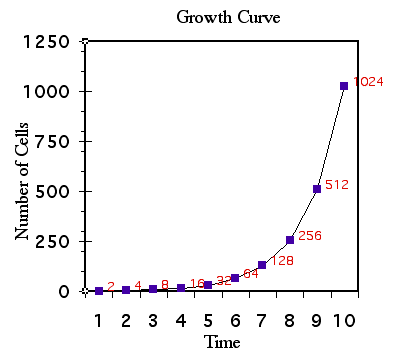

Many times investigators want to determine how quickly cells are dividing mitotically or growing (sometimes referred to as a doubling rate). A simple method to measure the rate of growth is to count the number of cells in a small volume (aliquot) at several time points and plot a growth curve (figure 1). A growth curve is not a curve so much as a graph of the number of cells counted at different time points. If the cells have unlimited space and nutrients, they should grow at an exponential rate since each daughter cell can also reproduce. As you can see from figure 1, the same growth curve data can be drawn on a linear scale or a log scale.


Figure 1. Growth curves. Top graph shows the rate of growth plotted on a linear scale. Bottom graph shows the same data plotted on a log scale.
Although cells can grow indefinitely if given the space, labs cannot afford to work with flasks that are too large. Therefore cells are often grown in a series of dilutions. For example, imagine 1000 cells were placed in a flask and later there were 1,000,000 cells in the same flask. If the cells get too crowded, their growth rate will slow down. To prevent this decrease in cell growth, an aliquot of the cells (e.g. one mL containing 1000 cells) will be added to a fresh flask and allowed to grow. The process of taking some cells from the flask and starting a new flask can continue until the investigator has enough cells to conduct the experiment. In the case of the bar code mutant yeast (Proteomics chapter), 60 generations of cells were produced. For the evolution of E. coli research (Sequence Variations Chapter), over 20,000 generations were grown over several years.
There are many different ways to measure growth rate. Sometimes, radioactive or epitope-tagged dNTPs are added to the cells' media. As the cells replicate their DNA, they incorporate the dNTPs into their DNA and this can be quantified. This method of DNA replication is usually reserved for living tissue samples or eukaryotic cells grown in culture dishes. Bacteria, yeast and other microbial organism are usually counted directly.
© Copyright 2002 Department of Biology, Davidson College, Davidson, NC 28036
Send comments, questions, and suggestions to: macampbell@davidson.edu